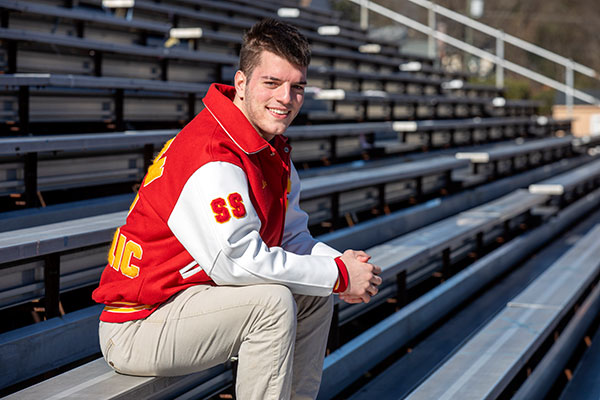
It was the last week of August in 2023, and the first game of the high school football season. Bergen Catholic was playing Red Bank Catholic and Chris Mimmo, 18, a Bergen Catholic senior and the varsity team captain, was about to make a play on the ball. When his foot hit the ground, he felt “a huge pop, kind of like someone hit me in the Achilles with a hammer,” he recalled. A poised athlete, Chris at first told himself to walk it off. But the next time he took a step, he collapsed.
The first half of the game was ending, so Chris’s father, Michael, had left the sidelines to grab a halftime snack. His cell phone started going off in his pocket with calls and texts from his family who were at the game. He picked up a call from his mother.
“You better get over here,” she told him. “Chris went down on the field and I think he’s hurt.”
Dr. Dennis Pfisterer, the chief of orthopedics at Holy Name and official team orthopedic surgeon for Bergen Catholic, was on the sidelines during the game, so he was able to examine Chris immediately. The diagnosis was readily clear: Chris had torn his Achilles tendon.
Chris was feeling a lot of emotions in the moments after his injury, and Dr. Pfisterer gave him the space he needed to process them. Chris told his parents he wanted to go to Dr. Pfisterer for the surgery he needed to repair the torn tendon. Dr. Pfisterer gave Michael his cell phone number so the family could reach him directly. Just three days after the injury, Chris had surgery at Holy Name.
“I felt very safe,” said Chris. “I don’t really like hospitals, but when I was in the waiting room I felt very comfortable with everybody that was there.”
Dr. Pfisterer mended Chris’s Achilles tendon using a new surgical process called the Achilles SpeedBridgeTM Repair, the same surgery that professional football player Aaron Rodgers had on his torn Achilles just a few weeks later. The surgery is designed to increase the tendon’s range of motion and weight-bearing ability post-procedure as compared to more conventional methods. Michael jokes that it was almost like the two athletes were “going through it together.” After the surgery Dr. Pfisterer put Chris’s foot and ankle in a cast for four weeks. A cast isn’t always used after the surgery used to repair an Achilles, but the doctor wanted to err on the side of caution.
Chris found the cast frustrating at first, but he saw the wisdom in Dr. Pfisterer’s decision and agrees that it helped him heal faster. After the cast came off, Chris switched to a walking boot and started physical therapy.
Nearly half a year later, Chris has started training and can run and jump again. He and his father credit Dr. Pfisterer with Chris’s speedy recovery, which is currently far ahead of where the average person would be.
“It’s a blessing that Dr. Pfisterer was on the field,” Michael said. “He’s absolutely amazing. Because he is the team doctor, he knew Chris’s personality and he really took extra care in making sure he was going to be safe.”

